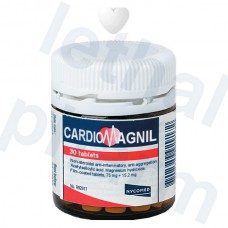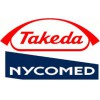Expiration date: 11/2026
Active substance: Acetylsalicylic acid, magnesium hydroxide.
Description pharmaceutical form:
Film-coated tablets comprising 75 / 15.2 mg of acetylsalicylic acid and magnesium hydroxide, respectively: tablets, film-coated, white in the form of a stylized "heart."
Film-coated tablets containing 150 / 30.39 mg of acetylsalicylic acid and magnesium hydroxide, respectively: tablets, film-coated, white, oval-shaped with the notch on one side.
Pharmacokinetics:
ASA is absorbed from the gastrointestinal tract almost completely. T1 / 2 ACK is around 15 minutes, as ASA involving enzymes quickly hydrolyzed to salicylic acid (SA) in the intestines, the liver and blood plasma. T1 / 2 SC is about 3 hours, but it may significantly increase, while a large dose of ASA (more than 3 g) as a result of saturation of enzyme systems.
Bioavailability ASA is about 70%, but this value varies largely because ASA presistemnomu undergoes hydrolysis (gastrointestinal mucosa, liver) in the UK under the action of enzymes. Bioavailability CK is 80-100%.
The doses used magnesium hydroxide does not affect the bioavailability of acetylsalicylic acid.
Description of the pharmacological actions:
The basis of the mechanism of action of acetylsalicylic acid (ASA) is irreversible inhibition of COX-1, resulting in blocked synthesis of thromboxane A2 and platelet aggregation is inhibited. It is believed that ASA has other mechanisms of inhibition of platelet aggregation, which expands the scope of its application in various vascular diseases. ASA also has anti-inflammatory, analgesic, antipyretic effect.
Magnesium hydroxide, which is part of cardiomagnyl, protects the gastrointestinal mucosa from the effects of ASA.
Testimony:
- Primary prevention of cardiovascular diseases such as thrombosis and acute heart failure in the presence of risk factors (such as diabetes, hyperlipidemia, hypertension, obesity, smoking, advanced age)
- prevention of recurrent myocardial infarction and thrombosis of blood vessels
- prevention of thromboembolism after surgery on blood vessels (coronary artery bypass grafting, percutaneous transluminal coronary angioplasty)
- unstable angina.
Contraindications:
- Hypersensitivity to ASA, the excipients of the drug and other NSAIDs
- hematencephalon
- tendency to bleeding (vitamin K deficiency, thrombocytopenia, bleeding diathesis)
- asthma induced by intake of salicylates and NSAIDs
- erosive and ulcerative gastrointestinal disease (exacerbation)
- gastrointestinal bleeding
- severe renal impairment (creatinine Cl - <10 ml / min)
- pregnancy (I and III trimesters)
- lactation
- deficiency of glucose-6-phosphate dehydrogenase
- concomitant use of methotrexate (> 15 mg per week)
- Children up to age 18 years.
Carefully:
- gout, hyperuricemia
- a history of ulcerative lesions gastrointestinal tract or gastrointestinal bleeding, kidney and / or liver failure, asthma, hay fever, nasal polyposis
- in allergic conditions
- in the II trimester of pregnancy.
Application of pregnancy and breastfeeding:
Application of large doses of salicylates in the first 3 months of pregnancy is associated with increased incidence of fetal defects. In the II trimester of pregnancy salicylates can be given only on the basis of strict risk assessment and benefit.
In the last trimester of pregnancy salicylates in high doses (> 300 mg / day) cause inhibition of labor, premature closure of the ductus arteriosus in the fetus, increased bleeding in the mother and the fetus, and the appointment just before birth may cause intracranial hemorrhage, especially in preterm infants.
Appointment of salicylates in the last trimester of pregnancy is contraindicated.
Use in lactation
Salicylates and their metabolites in small amounts into breast milk.
Accidental intake of salicylates during lactation is not accompanied by the development of adverse reactions in children and does not require stopping breastfeeding. However, long-term use of the drug or to appoint him to a high dose of breast-feeding should be discontinued immediately.
Side effect:
The frequency of adverse reactions listed below was determined according to the following: very often -> 1/10 -> 1/100 to <1/10 times -> 1 / 1000- <1/100 rare -> 1/10000 <1 / 1000 is very rare - <1/10000, including isolated reports.
Allergic reactions: urticaria (often), angioedema (often).
Immune system: anaphylactic reactions (sometimes).
GI: nausea (often), heartburn (very often), vomiting (often), pain in the stomach, the gastric mucosa and duodenal ulcers (sometimes), including: perforation (rare), gastrointestinal bleeding (sometimes), increased activity of "liver" enzymes (rare), stomatitis (rarely), esophagitis (very rare), erosive lesions of upper gastrointestinal (very rare), stricture (very rarely) , colitis (very rarely), irritable bowel syndrome (very rare).
Respiratory system: bronchospasm (often).
Hematopoietic system: increased bleeding (very often), anemia (rare), hypoprothrombinemia (very rare), thrombocytopenia (very rare), neutropenia, aplastic anemia (very rare), eosinophilia (very rare), agranulocytosis (very rare).
CNS: dizziness (sometimes), headache (common), insomnia (often), sleepiness (sometimes), tinnitus, intracerebral hemorrhage (rare).
Drug Interactions:
With simultaneous use of ASA enhances the effect of the following medicines:
- Methotrexate - by reducing renal clearance and displacement of its association with proteins
- Heparin and indirect anticoagulants - due to violations of platelet function and displacing anticoagulants from binding with proteins
- Thrombolytic and antiplatelet agents (ticlopidine)
- Digoxin - due to the decrease in its renal excretion
- Hypoglycemic agents (insulin and sulfonylurea derivatives) - due to the hypoglycemic properties of the ASA in high doses and displacement of sulfonylurea derivatives from its association with proteins
- Valproic acid - due to displacement from its association with proteins.
An additive effect is observed while receiving ASA and ethanol (alcohol).
ASA reduces the effect of uricosuric agents (benzbromaron) due to competitive tubular elimination of uric acid.
Leveraging the elimination of salicylates, systemic corticosteroids weaken their effect.
Antacids and cholestyramine reduce the absorption of the drug.
Dosage and administration:
Inside. The tablet is swallowed whole with water. If desired, tablets can break in half, chewed or pre-grind.
Primary prevention of cardiovascular diseases such as thrombosis and acute heart failure in the presence of risk factors (such as diabetes, hyperlipidemia, hypertension, obesity, smoking, advanced age) - 1 table. Cardiomagnyl containing ASA at a dose of 150 mg on the first day, and then - on 1 tab. Cardiomagnyl containing ASA 75 mg, 1 times a day.
Prophylaxis of recurrent myocardial infarction and thrombosis of blood vessels - Table 1. Cardiomagnyl containing ASA in doses of 75-150 mg, 1 times a day.
Prevention of thromboembolism after surgery on blood vessels (coronary artery bypass grafting, percutaneous transluminal coronary angioplasty) - Table 1. Cardiomagnyl containing ASA in doses of 75-150 mg, 1 times a day.
Unstable angina - Table 1. Cardiomagnyl containing ASA in doses of 75-150 mg, 1 times a day.
Overdose:
Symptoms of an overdose of moderate severity: nausea, vomiting, tinnitus, hearing loss, dizziness, confusion.
Treatment: gastric lavage, activated charcoal to take. Treatment is symptomatic.
Symptoms of severe overdose: fever, hyperventilation, ketosis, respiratory alkalosis, coma, cardiovascular and respiratory insufficiency, severe hypoglycemia.
Treatment: immediate hospitalization in specialized departments for emergency therapy - gastric lavage, determination of the acid-alkaline balance, alkaline and forced alkaline diuresis, dialysis, administration of solutions, activated carbon, symptomatic therapy. When conducting alkali diuresis values ??necessary to achieve a pH between 7.5 and 8. Forced diuresis alkali should be performed when the salicylate concentration in plasma is greater than 500 mg / l (3.6 mmol / L) in adults and 300 mg / L (2, 2 mmol / l) in children.
Special instructions:
The drug should be used when prescribing physician.
ASA may provoke bronchospasm and induce asthma attacks or other hypersensitivity reactions. Risk factors are the presence of a history of asthma, hay fever, nasal polyposis, chronic respiratory diseases and allergic reactions to other drugs (such as skin reactions, pruritus, urticaria).
ASA can cause bleeding of varying severity during and after surgery.
The combination of ASA with anticoagulant, thrombolytic and antiplatelet drugs is accompanied by an increased risk of bleeding.
ASA in low doses can trigger the development of gout in susceptible individuals (with a reduced excretion of uric acid).
The combination of ASA with methotrexate is accompanied by an increased incidence of side effects of hematopoiesis.
High doses of ASA have a hypoglycemic effect, it must be borne in mind when assigning its patients with diabetes receiving hypoglycemic agents.
When combined with the appointment of the SCS and salicylates should be remembered that during treatment the level of salicylate in the blood is reduced, and after the abolition of GCS possible overdose of salicylates.
We do not recommend the combination of ASA with ibuprofen, because the latter impairs beneficial effect of ASA on life expectancy.
Exceeding the dose ASA carries a risk of gastrointestinal bleeding.
Overdose is especially dangerous in elderly patients.
With the combination of ASA with alcohol increased the risk of damage to the gastrointestinal mucosa membrane and prolonged bleeding time.
Effects on ability to drive / moving mechanisms. Not visible.






